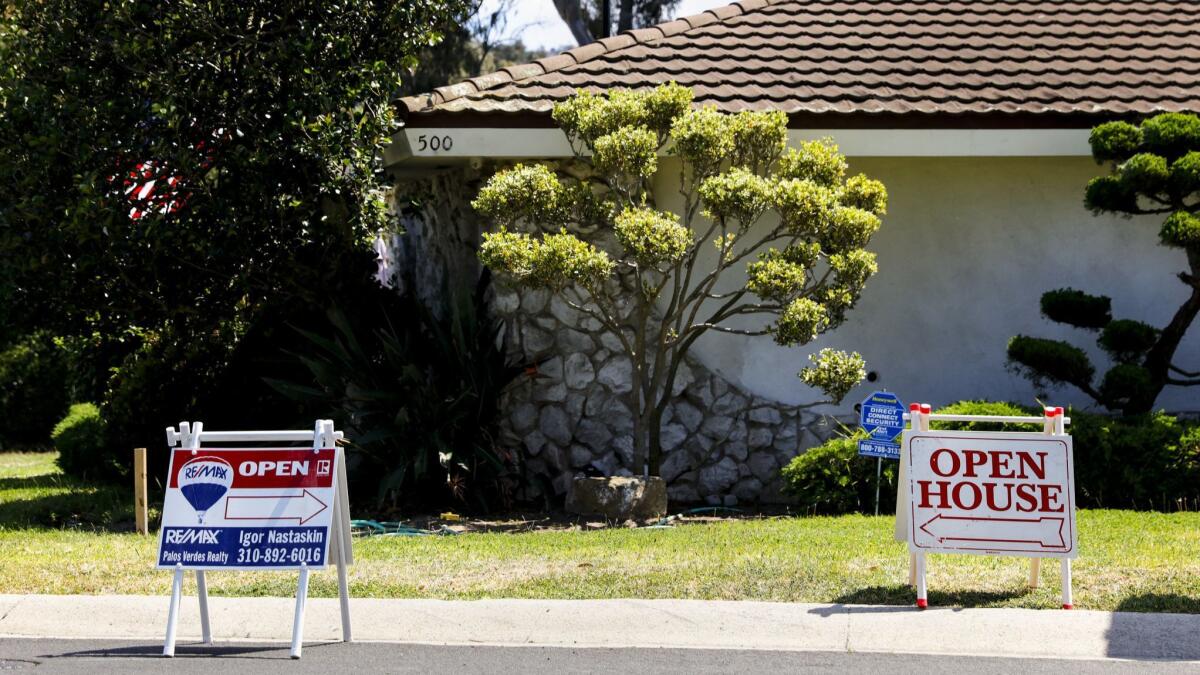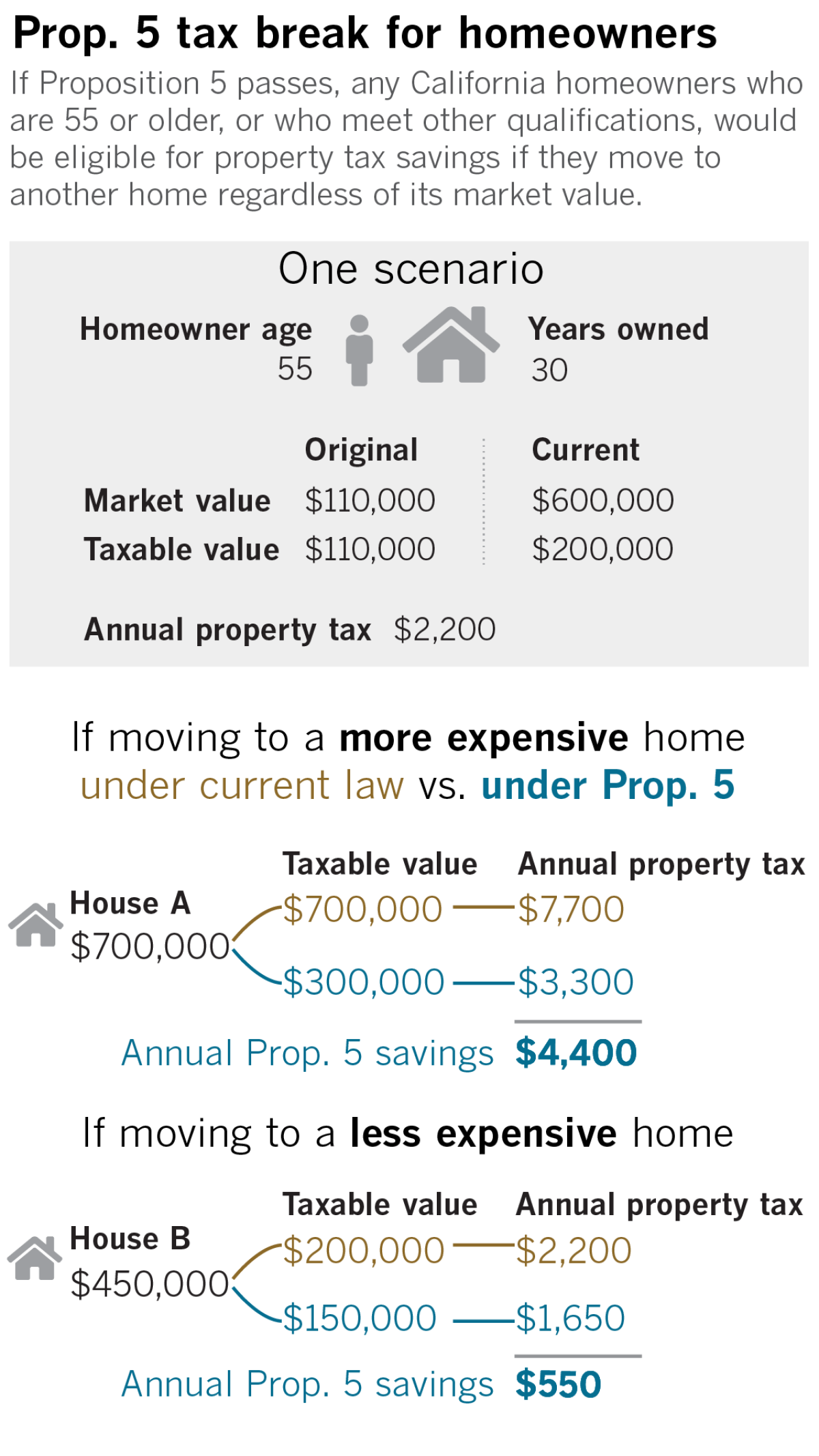Realtors say Proposition 5 would ‘unlock the housing market,’ freeing up more inventory. Experts don’t agree

- Share via
In a state with a persistent housing shortage, some believe older homeowners could provide some relief.
After all, Californians 55 and older own more than half of all owner-occupied homes. According to the California Assn. of Realtors, many want out of their large single-family houses but instead are “locked” in, unable or unwilling to pay the sharply higher property taxes that would accompany a new purchase, as dictated by the rules established 40 years ago under Proposition 13.
As a solution, the Realtors are pitching Proposition 5, which would let seniors move and carry their low property tax payments to any home, anywhere in the state, as many times as they like. The trade group, which has raised $13 million to support the measure, promises it will “unlock the housing market” and free up much needed inventory for young families.
“The utilization of the housing stock, it’s not necessarily efficient,” economist Jordan Levine of the Realtors group said. “You have a lot of folks in homes that don’t necessarily work for them.”
The complete list of L.A. Times endorsements for the November 6 election »
But, according to multiple outside housing experts, the measure is unlikely to unlock much of anything. Some data indicate that California seniors actually move more frequently than those elsewhere. And experts said it’s not clear a significant number of seniors, many of whom are wealthy, are ready to move only if they could keep their low property taxes.
“There are a lot of reasons people move or don’t,” said Christopher Thornberg, founding partner with Beacon Economics. Some never want to leave a longtime home, while others get an itch to downsize or be nearer to grandkids. “Property tax really isn’t that big of a deal.”
The measure, if it passes in November, may even contribute to rising prices, some experts said, as older households that would’ve sold anyway get a break and gain more buying power. Critics point out it’s expected to also reduce municipal tax revenues.
When Proposition 13 was approved in 1978, property values were soaring. Californians, particularly seniors on fixed incomes, worried they couldn’t keep pace with each new assessment.
So to provide stability, voters limited property tax to 1% of a home’s taxable value and capped how fast the valuation could rise, at 2% annually. That means the longer someone lives in a home, the more likely their taxes will be far below what someone would pay if they purchased the same house today.
After passage of other propositions in the 1980s, homeowners 55 or older can, once in their lifetimes, sell their home and transfer their under-market tax payments. But to qualify, the new home must be the same price or cheaper than the sales price of the old home — and, in most cases, must be in the same county. Only 11 counties, including Los Angeles and Orange, allow for inter-county transfers.
That’s what Dave Schmalz, 68, did. With the kids gone, he wanted out of the 3,669-square-foot house in Mount Washington that he and his now-ex-wife built in 1994. So two years ago, Schmalz sold the house — valued for tax purposes at about $650,000 — for $1.3 million. He split it with his ex-wife and, with his girlfriend, purchased a Glendale home half the size for $885,000. Under current rules, his $650,000 tax valuation came with him.
“That didn’t have anything to do with our decision to leave or stay,” he said. “It was just like, ‘Oh great, I can take advantage of this, so I will.’”
If Proposition 5 passes, seniors could use the benefit as many times as they want and there would be no restrictions on price or location of the new home. Like the current benefit, disaster victims and the severely disabled could also take advantage.

New property tax payments would be based on a mixture of the old valuation and new purchase price. If seniors purchased a less expensive home, the valuation would drop slightly. If they purchased a more expensive home, the valuation would rise slightly, but still be below — in some cases far below — what they purchased their new home for.
Asked for evidence that many seniors want to move but can’t afford a jump in property taxes, Levine of the Realtors group pointed out that seniors make up the majority of California homeowners and said his analysis shows single-family homes here sell less frequently than in the nation as a whole.
But other experts said different, more detailed data tell the opposite story. If property tax lock-in was keeping many older Californians from moving, they should move less frequently than seniors elsewhere, they said. But according to a Zillow analysis of Census Bureau data conducted for the Los Angeles Times, older Californians actually move more frequently than those elsewhere in the country.
In 2016, 3.5% of California homeowners 55 and older had moved from another place in California that year and purchased a house or condo within the state. Nationwide, the share of older homeowners who did the same thing within their state was 3.1%. When removing from the data California and Florida, which has a similar property tax system, the national number fell to 2.9%.
Similar differences existed in 2011, 2006 and 2001, Zillow said. A similar analysis from Beacon Economics found older California homeowners are about as likely to move as those in Texas, which doesn’t have Proposition 13-like restrictions.
Richard Green, director of the USC Lusk Center for Real Estate, theorized that California move rates weren’t lower in the Zillow data because many seniors are wealthy and can afford higher property taxes if they want to move. The median household income for potential Proposition 5 beneficiaries is $77,000, nearly 15% higher than the statewide median, according to the California Budget and Policy Center, a nonprofit that advocates for low-income residents.
“While tax policy may inhibit them” from moving, Green said, “the fact they have so much equity gives them extra wherewithal to move.”
Levine of the Realtors group said Proposition 5 was never meant to be a silver bullet for California’s affordability crisis, but is instead meant to help by removing a financial disincentive to move.
Aaron Terrazas, a senior economist with Zillow, wasn’t sure why Realtor data might show single-family homes sell less frequently in California, but Zillow data show Californians often move more frequently within their state. He noted, though, that Realtor data are less targeted toward an analysis of Proposition 5 and include sales by people who wouldn’t be able to use the measure, such as investors.
Other research has shown Proposition 13 reduces mobility, and Terrazas said higher move rates among older Californians could just reflect a higher share of wealthier homeowners who aren’t in the labor force — two characteristics that make seniors more likely to move in the first place. And he points out the next-oldest generation of California homeowners, those 35 to 54 years old, also moves within their state more than their counterparts nationwide.
Although Proposition 5 could indeed provide a sales boost, Terrazas doubted it would be by much, because older homeowners can already transfer low property tax payments to less expensive homes. The state’s nonpartisan Legislative Analyst’s Office, using research on how many home sales have been spurred by that benefit enacted in the 1980s, estimated Proposition 5 could lead to a “few tens of thousands” more older homeowners purchasing homes.
The analyst’s office said it couldn’t be more specific. But an increase of 40,000 home sales would have boosted home sales by 8% last year.
Fadel Lawandy, director of the Hoag Center for Real Estate and Finance at Chapman University, said such an increase could temper price growth slightly in some neighborhoods as seniors give up large single-family homes and downsize into condos or retirement communities.
But other experts say that seniors have to go somewhere and that not everyone will be moving to the desert. According to the Legislative Analyst’s Office, about 85,000 older households purchase a new home each year but don’t transfer their old property tax valuation. If Proposition 5 passes, those seniors are likely to use their extra buying power to bid up the cost of homes, according to the California Budget and Policy Center.
Giving a break to people who would’ve moved anyway would eventually cost local governments $1 billion annually and cost local schools another $1 billion, the analyst’s office says. (The Realtors dispute those numbers, saying a rise in construction to serve moving seniors would result in more homes on the property tax rolls, offsetting negative effects.)
Jonathan Kaplan, a senior policy analyst with the California Budget and Policy Center, said the measure is a double whammy for younger, lower-income Californians. Not only could they face higher home prices, he said, but they’d also share the burden of reduced revenues, through a reduction in services or a shift of the tax burden. The estimated revenue loss to schools would cost the state less than 1% of the state budget, but that is enough to provide 110,000 children with child care, Kaplan said.
“We have essentially a for-profit association in the Realtors doing what they can to strengthen and enrich their own pockets at the expense of almost every other service that enhances the quality of life in California,” said Brian Rice, president of the California Professional Firefighters, a union that is contributing money to the No on 5 campaign.
Times staff reporter Liam Dillon contributed to this report.
Follow me @khouriandrew on Twitter
More to Read
Inside the business of entertainment
The Wide Shot brings you news, analysis and insights on everything from streaming wars to production — and what it all means for the future.
You may occasionally receive promotional content from the Los Angeles Times.











